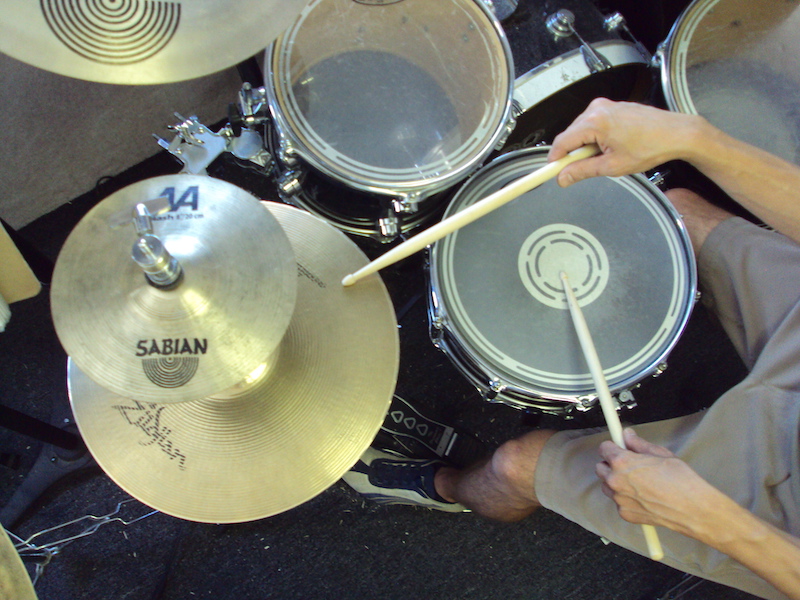
| DIFFERENCE BETWEEN AMATEURS AND EXPERTS |

3 STEPS TO MUSCLE MEMORY:
- LEARNING
- REHEARSING
- PERFECTING
The nature of drumming performance requires you to build muscle memory for the patterns and material you plan to use while playing.
You must remember: Your goal in learning a pattern is to have another piece of vocabulary you can use expressively. A pattern is useless to you if you can only half play it, and you need your concentration to avoid mistakes with it. You want something that feels alive, so you can use it onstage and in the studio.
THEREFORE:
Goals:
1. Make Only Progress, Not Frustration- Gain Motivation
2. Permanent Material In Your Vocabulary, Playable At Many Tempos/Volumes
3. Establish Your Ideal Practicing Habits For The Future
The problem: Wasteful Practicing Is Discouraging
Most people use their instinctive approach to practicing drums, which is usually ineffective and leads to discouragement… it involves setting a speed and THEN trying to get through a measure at that speed. If the material falls apart, most people just stop and try the same thing from the beginning again. And again, and again… This is a total waste of time.
The solution: Simple method will spark your enthusiasm
Once you get used to the process of learning effectively, you will come to enjoy it immensely. It will be natural to learn something new.
The habit of effective practicing – in control and very few mistakes – is the largest direct source of motivation for your drumming. Progress tends to encourage itself, because you get used to this way of practicing, so you don’t mind, PLUS it feels good to have increased abilities and vocabulary.
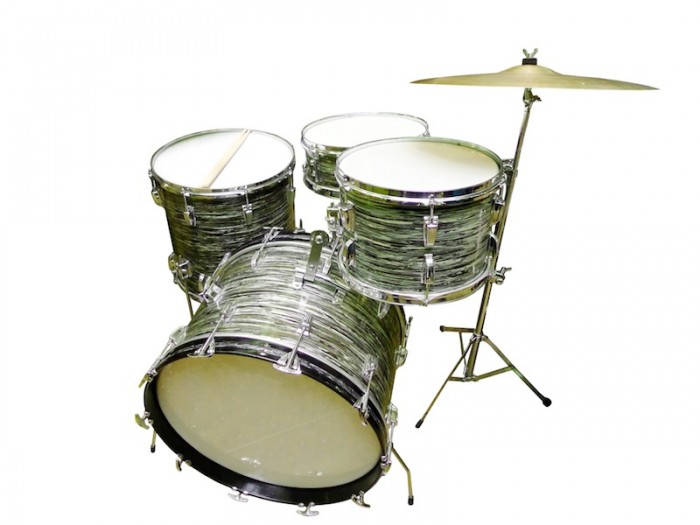
What is ‘muscle memory’?
Muscle memory basicaly means programming yourself like a computer/machine.
It means rehearsing (correctly repeating) a physical action until it becomes a habit that no longer requires your mind. It allows you to execute grooves, fills, rhythms, and other musical patterns while you use your attention for important things such as listening to other musicians you’re playing with.
WHY: It is vital to control many of your musical actions with muscle memory, so that you can be a good musician- which involves being a very active listener while playing.
3 STEPS: Learning – Absorbing to muscle memory – Polishing to bring to life
Here are the steps to take for creating muscle memory:
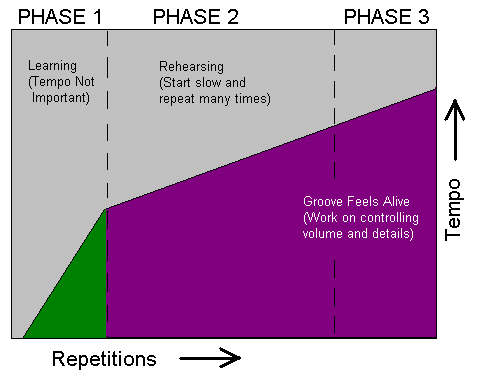
Phase 1: Learn / Memorize A Pattern Carefully
The end goal for this step is to be able to play the pattern at a slow and steady tempo, at least 5-10 times in a row, without worrying about the risk of mistakes. Tempo is unimportant to learning the pattern, so go slowly at first.
Mentally brace yourself for this: when practicing, a good percentage of time is spent going really slowly and carefully.
1. Identify length of the repeating pattern, so you can strategically practice parts of the ‘loop’.
2. First play one count at a time at any pace, with no tempo, to absorb each one fully. Go slow enough NOT TO MAKE ANY MISTAKES- take your sweet time.
3. Once you can repeat the pattern, try including the spaces in your counting, and play the pattern slowly with steady timing. Don’t allow mistakes, seriously. Just go ridiculously slow and keep repeating- the magic will happen on its own.
Phase 2: Repetition
This step is the rehearsal. It involves allowing the pattern to sink in rather than trying to force it.
1. Simply repeat the pattern without a time limit, until you NOTICE your ability to play it becoming easier. Don’t rush or think about this process, just distract yourself with enjoying the groove and the new movements, and you will discover that your body is gaining muscle memory.
2. Pay attention to the feel of the pattern, and try adjusting details to make it sound good.
3. Play the pattern across a wide range of tempos and volumes, to make it versatile. (You can increase the speed using the ‘Stair-Step’ method, shown below.) Your goals with any pattern are to learn how to play it all over the volume and tempo graph, so it will be ready for most any musical situation.
The ‘stair-step’ method for gaining speed:
1) find the highest comfortable tempo you can, where you can gain control over details like volume levels, and make the pattern feel alive and expressive.
2) Repeat the pattern at that tempo for several minutes, or until the pattern is just itching to be played faster.
3) Find the next comfortable tempo up, where you can still control all details and make the pattern feel alive.
4) Repeat steps 2 and 3 as many times as you wish.
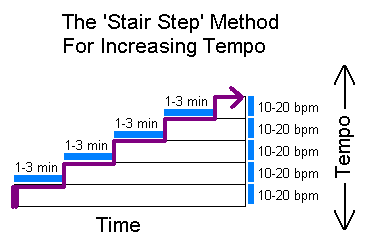
Phase 3: Bring The Pattern To Life
1. Focus on details and making adjustments to volume, timing, and attitude.
2. Put yourself in the shoes of an audience- any type of audience. Imagine being onstage, or having some friends in the room, etc.
3. Use your judgment: make the pattern FEEL GOOD. Make it feel truly alive.
You don’t want to just learn to play a pattern with mediocre quality, or else you can’t use it while performing ever. You want everything you practice to get that ‘sheen’ that makes it feel good. Even the simplest sticking pattern, like double strokes on a practice pad, can sound and feel beautiful depending on who’s playing them- or actually depending on how well that person learned to make double strokes feel good. You can do the same.
There’s only one real way to do this polishing: Lots of time, repetition and ‘settling’. You will continue to gradually get better at playing any given pattern, even after weeks and months, as your body and mind continue getting more used to it.
9 TIPS

Tip #1: Motivation is always the goal
This lesson is designed to help you enjoy your drumming path as much as possible. There is no point in wasting any of your practice time, because it will only discourage you and make practice less appealing. Every moment of training should be productive, because you will begin to love the art of practicing.

Tip #2: Practice Carefully
Mistakes that you repeat become muscle memory too. Watch out! Make sure you repeat things carefully. Mistakes are to be avoided, and have no purpose. Don’t feed them!

Tip #3: Stay Focused And Mindful
EXPERIENCING your practicing helps you learn and progress more quickly. Intense focus gives you more control, during any part of the pattern you need it. You can narrow in on one tricky part of a measure, for example, to make sure you get it right. Or, you can hold onto a higher speed than you’re used to, for a brief time, with extra concentration.
When you’re doing something intense, like playing in a basketball game or running downhill on rocky terrain, your focus gets really intense automatically – try using that same mindset to stay in control and focused when playing drums.

Tip #4: Control is your top priority, not speed
When learning a pattern, most people have a strong constant impulse to play at a steady speed, which is how the pattern will sound when it’s learned. Unfortunately, this prevents you from gaining the control you need to play the pattern at a constant speed and increase its tempo.

Tip #5: Divide And Conquer
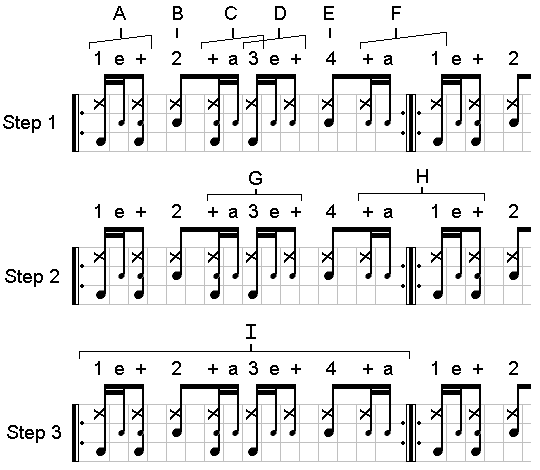
If the pattern is 6 counts or longer, and is difficult to play all the way through repeatedly, then ‘divide and conquer’. This is the best trick in the book, and it works great. Simply look for any naturally isolated chunks of 3-5 consecutive notes at a time, or designate your own. Always choose them so they overlap each other. Practice each one of these like it’s an individual exercise, until you’ve mastered it. Then pair them up and practice the new longer patterns, and when those are comfortable then begin learning the entire pattern, if you haven’t already. Make sure to include the spaces, and that you can play the pattern in steady counts.

Tip #6: Repeat Pattern Without Urgency, Learn Effortlessly
Stay Relaxed And Patient, and enjoy the process of repeating the pattern. Turn it over as you appreciate different ways to experience it, different aspects of it. You’ll absorb the most quickly when you’re calm and relaxed, just enjoying the process of playing something new really slow a bunch of times.

Tip #7: Don’t underestimate practicing various volumes and tempos
When you have enough control, experiment with different tempos and volume inflections to get the groove sounding and feeling good. What if you could play an incredible groove and wanted to use it onstage in a song, but the song was too slow for you to get the groove into the pocket, because you haven’t practiced that yet? Or if the groove wouldn’t fit in the pocket because parts of it were too loud? If you learn a groove without polishing it, it’s useless to you onstage. In other words, everything you practice should get polished and brought to life at various tempos and volumes.

Tip #8: If you hit a plateau in your progress, come back later.
Don’t be afraid to take a break in learning a pattern, because when you resume practice you will often have the advantage of a fresh approach that can help you make another burst of progress.

Tip #9: How much muscle memory do you need?
Muscle memory is not a switch that flips on and BOOM you have it. It’s more of a range, from ‘don’t know how’ to ‘could do it in my sleep’. The more experience and time you’ve accumulated with the pattern, the further it goes on this range. The more you rehearse, the more control you will gain.
